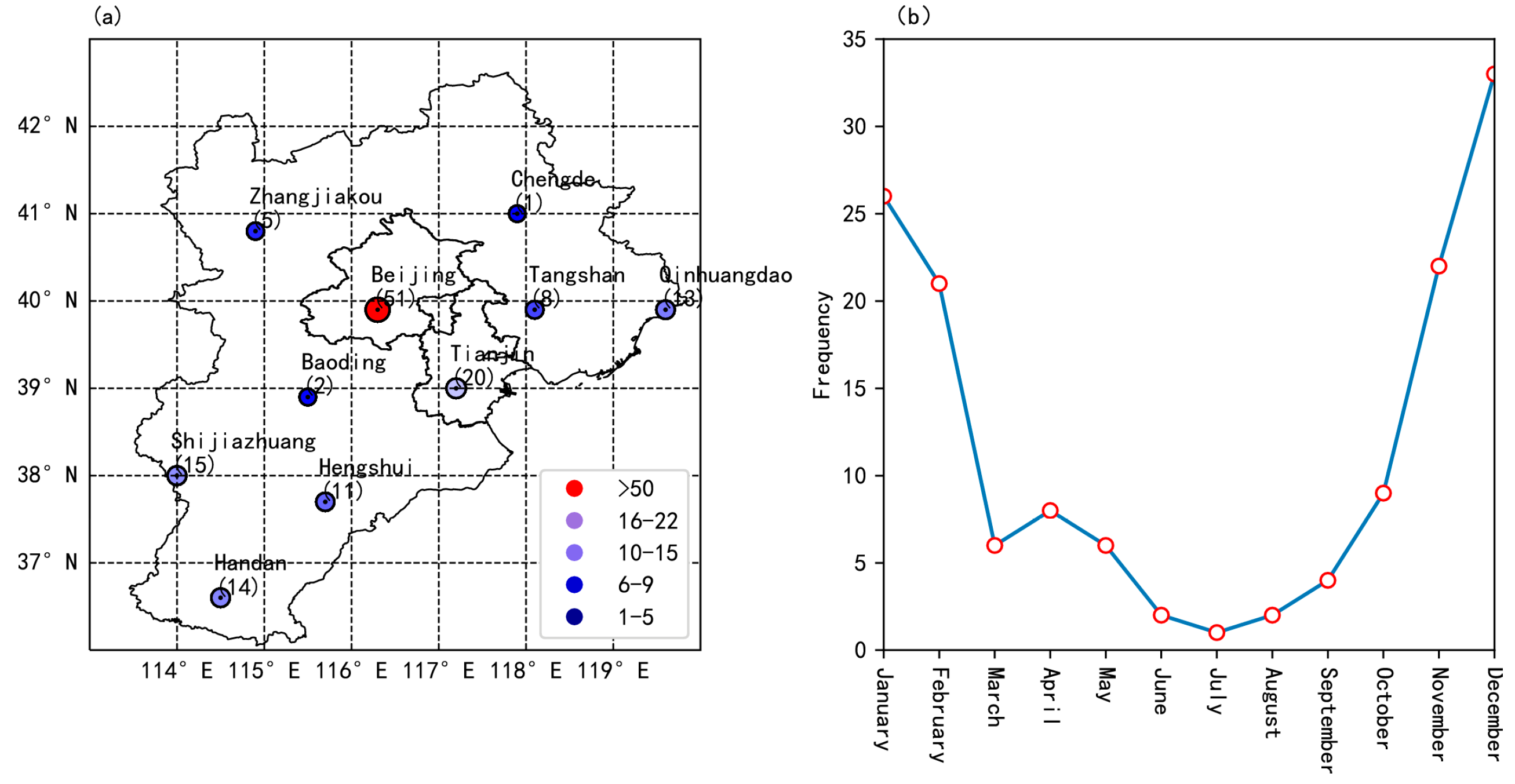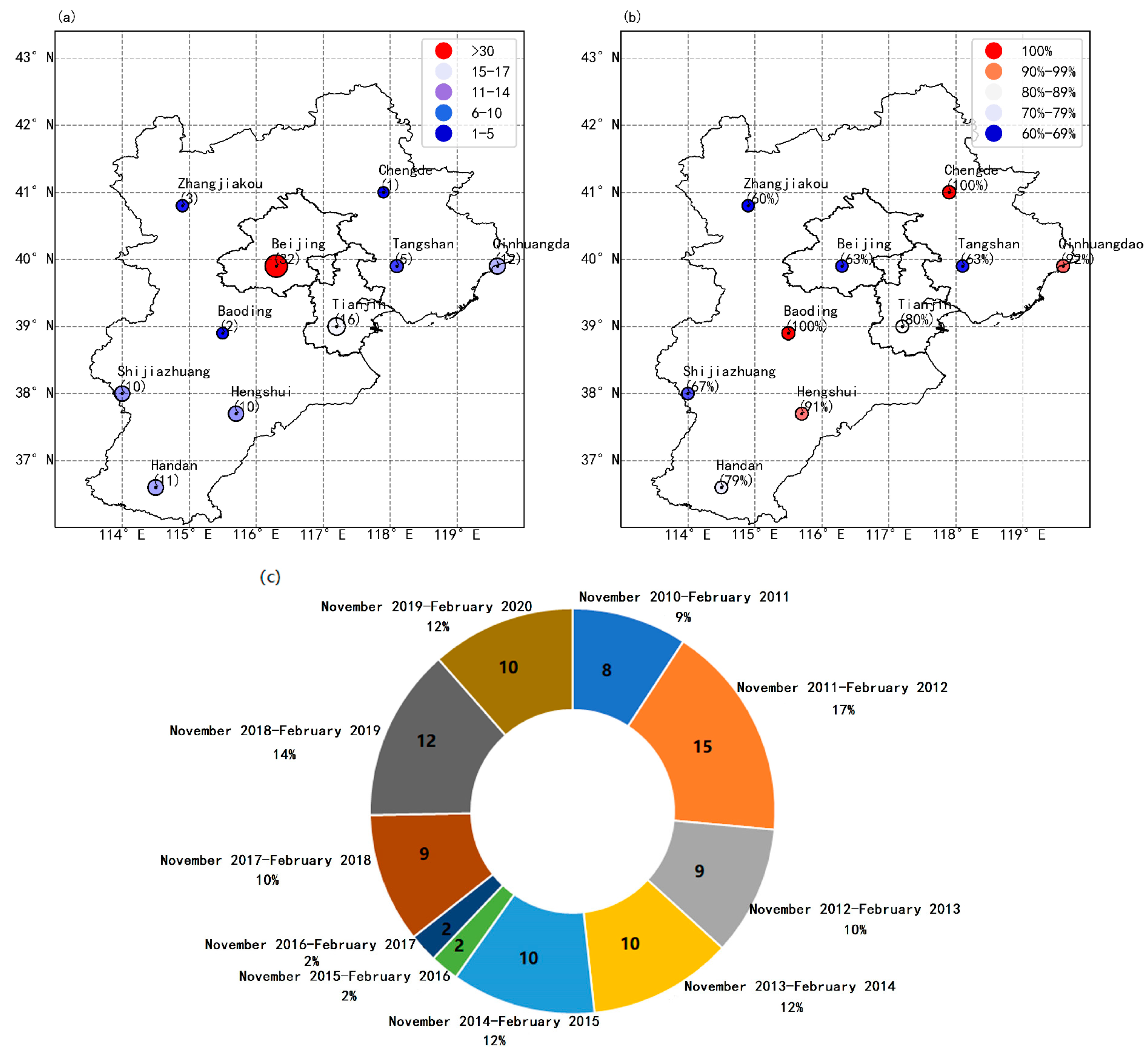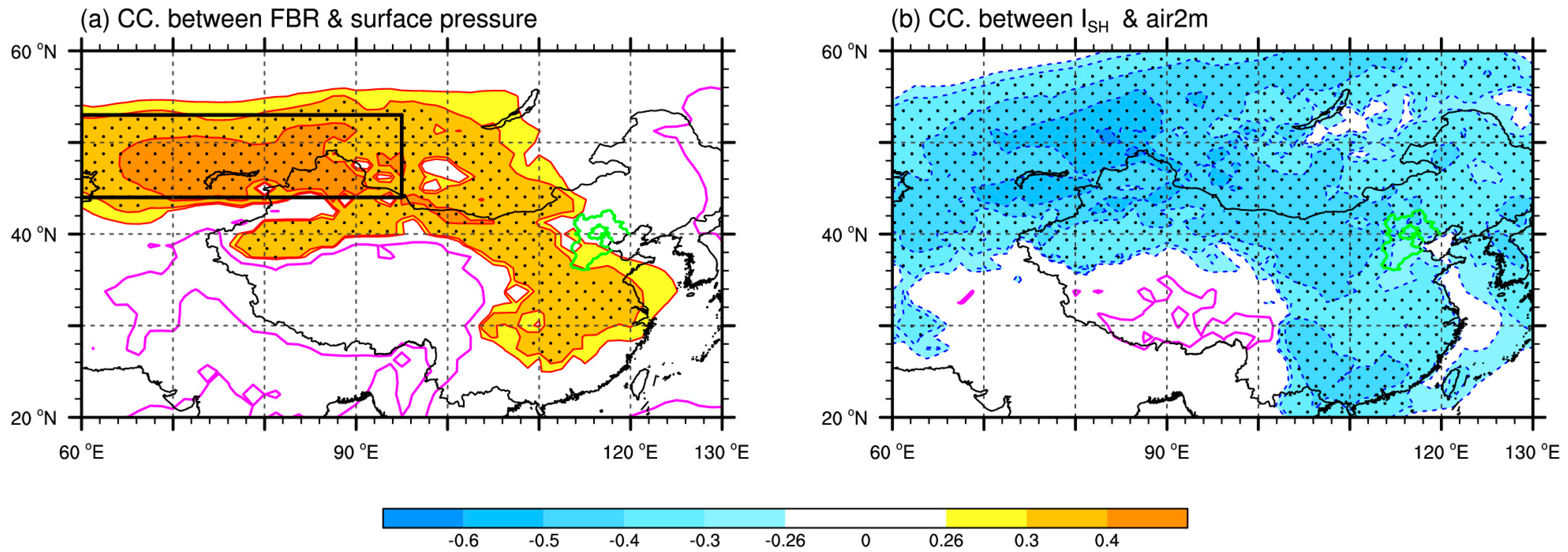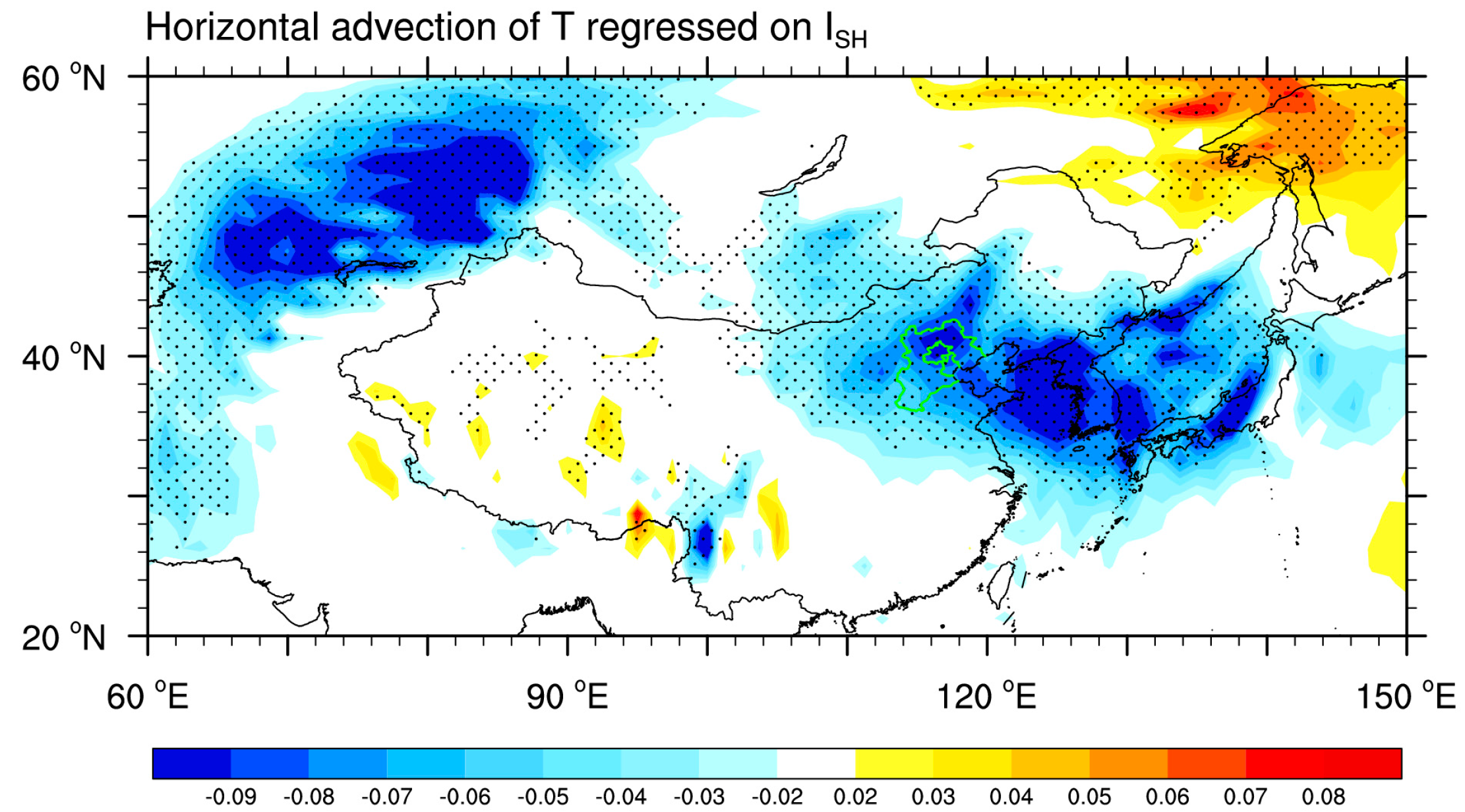Association between the Rail Breakage Frequency in Beijing–Tianjin–Hebei High-Speed Railway and the Eurasian Atmospheric Circulation Anomaly
Abstract
1. Introduction
2. Data and Methods
3. Spatio-Temporal Variability of FRB in BTH Region during Winter
4. Relationship between the FRB in BTH Region and the Siberian High Anomaly
5. Discussion and Conclusions
- The spatial and temporal distribution of the total FRB in BTH is very uneven. The maximum FRB in Beijing is 51, and the minimum FRB in Chengde is 1. There are obvious seasonal differences in FRB, with the most frequent rail breaks in winter, followed by spring and autumn, and the least in summer.
- The spatial and temporal variability in winter FRB of BTH region is also obvious, and its spatial distribution is similar to that of the annual total FRB. The highest and lowest winter FRB are located in Beijing and Chengde respectively, with 32 and 1 broken rails respectively. The percentage of winter FRB in all regions exceeds 60% of the total annual FRB, and some regions, such as Baoding and Chengde, have 100% of the total FRB in winter. There is also a very obvious interannual variation in the winter FRB.
- A significant positive correlation between the winter FRB in BTH region and the Siberian high is found. When the Siberian high is strong, it is accompanied by positive potential height anomalies and anomalous anticyclonic circulation over the Siberian region, as well as negative potential height anomalies and anomalous cyclonic circulation over the northeastern Asian region. These circulation anomalies show an equivalent barotropic feature in the vertical direction and produce the anomalous northwesterly prevailing over BTH region in the lower troposphere, enhance the East Asia winter monsoon, and deepen East Asian trough in the middle troposphere. All the above circulation anomalies are conducive to the cold air advection from high latitudes to BTH region, causing winter cooling in the BTH region, thus providing low temperatures for rail breakage.
Author Contributions
Funding
Institutional Review Board Statement
Informed Consent Statement
Data Availability Statement
Conflicts of Interest
References
- Wang, Y.; Li, K.; Xu, X.; Zhang, Y. Transport energy consumption and saving in China. Renew. Sustain. Energy Rev. 2014, 29, 641–655. [Google Scholar] [CrossRef]
- Li, X.; Yan, J. Research on the Development of Railway Industry in China and the Correlation between Railway and National Economy Based on Input-Output Analysis; Beijing Jiaotong University: Beijing, China, 2016; pp. 1–3. [Google Scholar]
- Zhao, H.; Liang, J.; Liu, C. High-Speed EMUs: Characteristics of technological development and trends. Engineering 2020, 6, 234–244. [Google Scholar] [CrossRef]
- Xiao, Q.; Zheng, J.; Liu, J.; Fang, J. Analysis of the wheel/rail rolling contact fatigue of a high-speed train under the transient mechanism. J. Mech. Sci. Technol. 2017, 31, 2235–2242. [Google Scholar] [CrossRef]
- Magel, E.; Mutton, P.; Ekberg, A.; Kapoor, A. Rolling contact fatigue, wear and broken rail derailments. Wear 2016, 366–367, 249–257. [Google Scholar] [CrossRef]
- Shur, E.; Borts, A.; Zakharov, S. Rails for Low Operating Temperature and High Speed. Transp. Soil Eng. Cold Reg. 2020, 1, 221–232. [Google Scholar]
- Chen, W.; Graf, H.F.; Huang, R. The Interannual Variability of East Asian Winter Monsoon and Its Relation to the Summer Monsoon. Adv. Atmos. Sci. 2000, 17, 48–60. [Google Scholar]
- Ding, Y.H. Monsoons over China; Springer Science & Business Media: Berlin/Heidelberg, Germany, 1994; p. 432. [Google Scholar]
- Thompson, D.W.J.; Wallace, J.M. The Arctic Oscillation signature in the wintertime geopotential height and temperature fields. Geophys. Res. Lett. 1998, 25, 1297–1300. [Google Scholar] [CrossRef]
- Thompson, D.W.J.; Wallace, J.M. Annular modes in the extratropical circulation. Part I: Month-to-month variability. J. Clim. 2000, 13, 1000–1016. [Google Scholar] [CrossRef]
- He, C.; He, J. Relation between Arctic Oscillation and North China Air Temperature in Winter. J. Nanjing Inst. Meteorol. 2003, 26, 1–7. (In Chinese) [Google Scholar]
- Wallace, J.M.; Gutzler, D.S. Teleconnections in the geopotential height field during the Northern Hemisphere winter. Mon. Weather Rev. 1981, 109, 784–812. [Google Scholar] [CrossRef]
- Wang, N.; Zhang, Y. Evolution of Eurasian teleconnection pattern and its relationship to climate anomalies in China. Clim. Dyn. 2015, 44, 1017–1028. [Google Scholar] [CrossRef]
- Luo, B.H.; Luo, D.H.; Dai, A.G.; Simmonds, I.; Wu, L. A connection of winter Eurasian cold anomaly to the modulation of Ural blocking by ENSO. Geophys. Res. Lett. 2021, 48, e2021GL094304. [Google Scholar] [CrossRef]
- Yao, Y.; Zhang, W.; Luo, D.; Zhong, L.; Pei, L. Seasonal Cumulative Effect of Ural Blocking Episodes on the Frequent Cold events in China during the Early Winter of 2020/21. Adv. Atmos. Sci. 2022, 39, 609–624. [Google Scholar] [CrossRef]
- Branstator, G. Circumglobal Teleconnections, the Jet Stream Waveguide, and the North Atlantic Oscillation. J. Clim. 2002, 15, 1893–1910. [Google Scholar] [CrossRef]
- Huang, W.; Yang, Z.; He, X.; Lin, D.; Wang, B.; Wright, J.S.; Chen, R.; Ma, W.; Li, F. A possible mechanism for the occurrence of wintertime extreme precipitation events over South China. Clim. Dyn. 2019, 52, 2367–2384. [Google Scholar] [CrossRef]
- Cohen, J.; Saito, K.; Entekhabi, D. The role of the Siberian high in Northern Hemisphere climate variability. Geophys. Res. Lett. 2001, 28, 299–302. [Google Scholar] [CrossRef]
- Gong, D.; Ho, C.H. The Siberian High and climate change over middle to high latitude Asia. Theor. Appl. Climatol. 2002, 72, 1–9. [Google Scholar] [CrossRef]
- Lu, C.; Zhang, Y.; Guan, Z. Winter anticyclone activities in Siberia and their relationship to the regional temperature anomaly. Int. J. Climatol. 2022, 42, 6429–6440. [Google Scholar] [CrossRef]
- Hersbach, H.; Bell, B.; Berrisford, P.; Hirahara, S.; Horány, A.; Muñoz-Sabater, J.; Nicolas, J.; Peubey, C.; Radu, R.; Scheper, D.; et al. The ERA5 global reanalysis. Q. J. R. Meteorol. Soc. 2020, 146, 1999–2049. [Google Scholar] [CrossRef]
- Wu, J.; Gao, X. A gridded daily observation dataset over China region and comparison with the other datasets. Chin. J. Geophys. 2013, 56, 1102–1111. (In Chinese) [Google Scholar]
- Huo, L.; Wang, J.; Jin, D.; Luo, J.; Shen, H.; Zhang, X.; Min, J.; Xiao, Y. Increased summer electric power demand in Beijing driven by preceding spring tropical North Atlantic warming. Atmos. Ocean. Sci. Lett. 2022, 15, 100146. [Google Scholar] [CrossRef]
- Hasanean, H.M.; Almazroui, M.; Jones, P.D.; Alamoudi, A.A. Siberian high variability and its teleconnections with tropical circulations and surface air temperature over Saudi Arabia. Clim. Dyn. 2013, 41, 2003–2018. [Google Scholar] [CrossRef]
- Hoskins, B.J.; Karoly, D.J. The steady linear response of a spherical atmosphere to thermal and orographic forcing. J. Atmos. Sci. 1981, 38, 1179–1196. [Google Scholar] [CrossRef]
- Takaya, K.; Nakamura, H. Mechanisms of intraseasonal amplification of the cold Siberian high. J. Atmos. Sci. 2005, 62, 4423–4440. [Google Scholar] [CrossRef]
- Maeda, S.; Takemura, K.; Kobayashi, C. Planetary Wave Modulations Associated with the Eurasian Teleconnection Pattern. J. Meteorol. Soc. Jpn. Ser. II 2021, 99, 449–458. [Google Scholar] [CrossRef]
- O’Neill, B.C.; Tebaldi1, C.; Van Vuuren, D.P.; Eyring, V.; Friedlingstein, P.; Hurtt, G.; Knutti, R.; Kriegler, E.; Lamarque, J.F.; Lowe, J.; et al. The Scenario Model Intercomparison Project (ScenarioMIP) for CMIP6. Geosci. Model Dev. 2016, 9, 3461–3482. [Google Scholar] [CrossRef]
- Reddy, V. Modelling and Analysis of Rail Grinding & Lubrication Strategies for Controlling Rolling Contact Fatigue (RCF) and Rail Wear. Ph.D. Thesis, Queensland University of Technology, Brisbane City, QLD, Australia, 2004; p. 43. [Google Scholar]
- Ciotlaus, M.; Kollo, G.; Marusceac, V.; Orban, Z. Rail-wheel interaction and its influence on rail and wheels wear. Procedia Manuf. 2019, 32, 895–900. [Google Scholar] [CrossRef]
- Gao, Y.; Wang, P.; Wang, K.; Xu, J.; Dong, Z. Damage tolerance of fractured rails on continuous welded rail track for high-speed railways. Rail. Eng. Sci. 2021, 29, 59–73. [Google Scholar] [CrossRef]





Disclaimer/Publisher’s Note: The statements, opinions and data contained in all publications are solely those of the individual author(s) and contributor(s) and not of MDPI and/or the editor(s). MDPI and/or the editor(s) disclaim responsibility for any injury to people or property resulting from any ideas, methods, instructions or products referred to in the content. |
© 2023 by the authors. Licensee MDPI, Basel, Switzerland. This article is an open access article distributed under the terms and conditions of the Creative Commons Attribution (CC BY) license (https://creativecommons.org/licenses/by/4.0/).
Share and Cite
Huo, L.; Xiao, L.; Wang, J.; Jin, D.; Shi, Y.; Zhang, Q. Association between the Rail Breakage Frequency in Beijing–Tianjin–Hebei High-Speed Railway and the Eurasian Atmospheric Circulation Anomaly. Atmosphere 2023, 14, 561. https://doi.org/10.3390/atmos14030561
Huo L, Xiao L, Wang J, Jin D, Shi Y, Zhang Q. Association between the Rail Breakage Frequency in Beijing–Tianjin–Hebei High-Speed Railway and the Eurasian Atmospheric Circulation Anomaly. Atmosphere. 2023; 14(3):561. https://doi.org/10.3390/atmos14030561
Chicago/Turabian StyleHuo, Liwei, Linman Xiao, Ji Wang, Dachao Jin, Yinglong Shi, and Qian Zhang. 2023. "Association between the Rail Breakage Frequency in Beijing–Tianjin–Hebei High-Speed Railway and the Eurasian Atmospheric Circulation Anomaly" Atmosphere 14, no. 3: 561. https://doi.org/10.3390/atmos14030561
APA StyleHuo, L., Xiao, L., Wang, J., Jin, D., Shi, Y., & Zhang, Q. (2023). Association between the Rail Breakage Frequency in Beijing–Tianjin–Hebei High-Speed Railway and the Eurasian Atmospheric Circulation Anomaly. Atmosphere, 14(3), 561. https://doi.org/10.3390/atmos14030561






